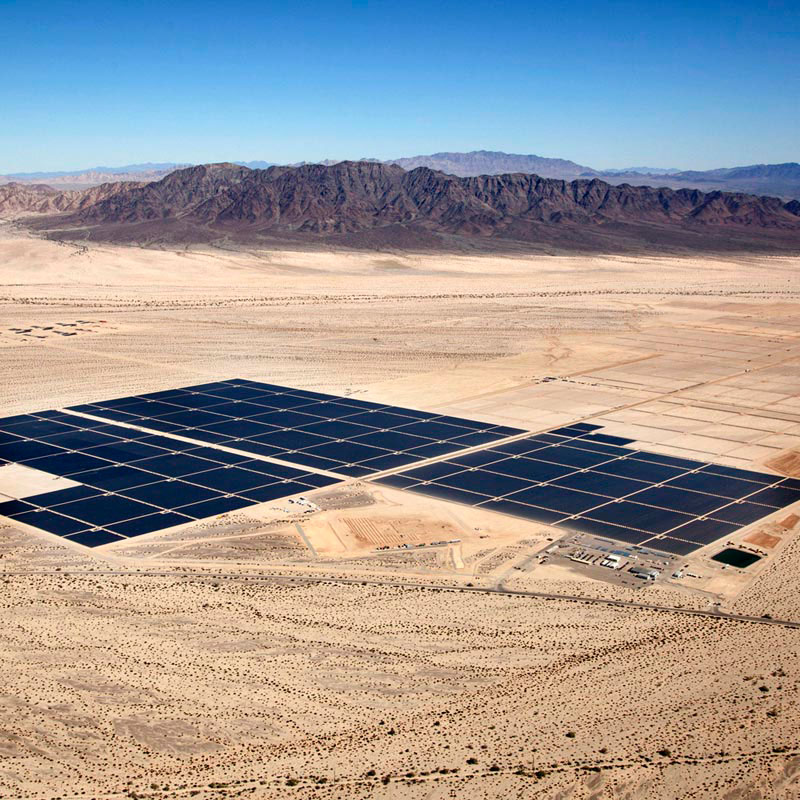 Photo courtesy of Desert Sunlight
Photo courtesy of Desert Sunlight
On the surface, California and Morocco could not be more opposite. One, of course, is an American state, while the other is a North African country and located on the other side of the globe.
But the two locales have one common topographical characteristic — swaths of desert land — and the leaders of the two regions have a replicate goal: taking what otherwise would be unused property and repurposing it for a variety of efforts aimed at enhancing clean energy programs across the globe.
While many governing bodies throughout the planet — at the national, state and local levels — are attempting to look at ways of reducing their carbon footprint, the state of California and Moroccan federal leaders have embarked on two of the most ambitious goals to date.
From a strictly observational standpoint, a desert might not seem a hotbed for environmentally sustainable practices. By virtue of its very name, green practices typically are associated with lush landscapes and bountiful amounts of water.
But a new wave of scientists and environmentalists are working in tandem on bringing clean energy practices into deserts. As it turns out, these vast swaths of land with arid climates are ripe for solar thermal power plants, which are able to capture the sun’s energy as heat. Once that process is completed, water is converted into steam and, presto!, turbines are powered — strictly and solely through clean energy practices.
As EcoWatch points out, plans are in motion for both regions to derive their power from green energy by 2030, and both are at different stages in achieving that goal. “While California has been working at it longer and is already halfway to its goal (as of December 2015), Morocco is moving aggressively to catch up,” EcoWatch’s Peyton Fleming notes.
California’s Sunlight Solar Farm
The California Energy Commission has been actively working in the state’s desert areas to create renewable energy sources. At the heart of all this is a solar farm that is part of an initiative known as Desert Sunlight in the state’s southeastern corner.
The solar farm is located near Joshua Tree National Park, near the town of Desert Center, in Riverside County. It has been touted as a project that, in the long run, will drastically cut down on traditional energy costs with a ramped up reliance on renewable energy sources.
California’s commissioners gleaned a number of statistics as clean energy goals within Desert Sunlight progress:
- At the moment, Desert Sunlight is considered the largest solar project, when measured through a technical measurement system known as photovoltaic (or PV).
- The solar farm, in its entirety, encompasses 3,800 acres of land.
- Through 2016, the U.S. Bureau of Land Management is managing the site, though it will change hands and is expected to be integrated into the state of California’s grid system by early 2017.
- The program provides enough renewable energy to power more than 160,000 homes in Riverside County.
- In its current iteration, the solar farm has displaced land that had comprised more than 300,000 metric tons of carbon dioxide each year.
- The reduction in the carbon footprint within the desert region is the equivalent of 60,000 cars each year.
Because of the upfront cost, projects such as Desert Sunlight do not occur overnight. President Barack Obama’s American Recovery and Reinvestment Act in 2009 helped spark the project through a loan guarantee granted through the U.S. Department of Energy.
Construction work on Desert Sunlight began in 2011, and most of the substantial infrastructure work was completed by 2015. Additional enhancements could take place in the years ahead.
Morocco’s grandiose Concentrated Solar Power plant
After years of working overtime, Morocco’s clean energy ambassadors in early 2016 took the wraps off its extensive Concentrated Solar Power (CSP) plant. Situated within the Saharan Desert, the CSP is approximately the same size as Rabat, Morocco’s capital city.
As this NPR report points out, the CSP, in its first phase, is expected to provide renewable energy to about a million Moroccans. The country’s energy agency is planning the role out of its renewable energy facility in three phases.
“When the next two phases are finished, the plant will be the single largest solar power production facility in the world,” the NPR article states. The Moroccan government is naming each phase of the project. The initial kick-off site is referred to as Noor I, and subsequent phases will be aptly referred to as Noor II and Noor III.
As details of the expansive CSP project have come to light, there are some interesting details. Among them:
- When fully complete, the Noor I power plant will be capable of generating up to 160 megawatts of power.
- The facility, located near the Moroccan town of Ouarzazate, is going to cover thousands of acres of land within the Sahara.
- Economically speaking, the CSP will have a substantially positive impact on Morocco. A whopping 97 percent of the country’s energy consumption was through imported sources before the first phase of the CSP was constructed.
The World Bank is helping fund all three phases of Morocco’s CSP project. In addition to reducing the carbon footprint, Moroccan leaders are cheering the project because it will drastically cut down on what has long been one of the country’s most significant imported sources.
The Desert Research Institute
While much of the recent talk surrounding clean energy amid the backdrop of desert landscapes is focused on California and Morocco, there is one other notable organization, the Desert Research Institute. Members of the Nevada-based agency look into eco-friendly practices.
As the institute’s website states, it “is committed to discovering new economically and environmentally friendly energy production methods. DRI supports expanding renewable energy research throughout Nevada and around the U.S.”
In other words, it is possible deserts could play an even larger role in the future as new and emerging sustainable practices are explored.